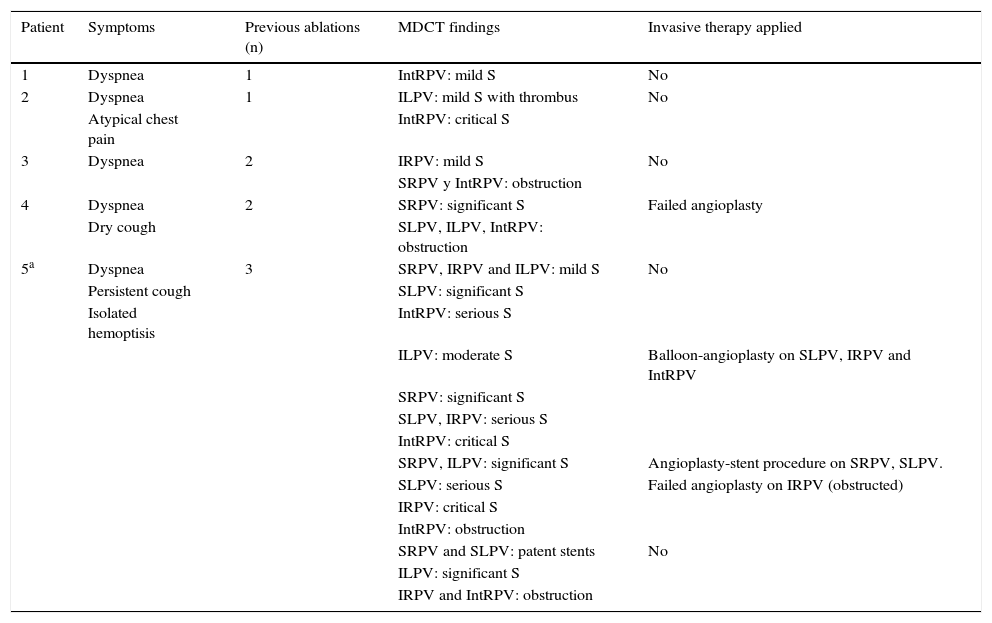To analyze the usefulness of multidetector computed tomography (MDCT) in the preprocedural evaluation and follow-up of patients undergoing radiofrequency ablation of pulmonary veins and the impact of the MDCT findings on the approach to treatment.
MethodWe retrospectively analyzed 92 consecutive MDCT studies done in 80 patients between January 2011 and June 2013; 70 (76%) studies were done before a first ablation procedure and 22 (24%) were done in patients who had undergone an ablation procedure.
ResultsFindings were useful in 34% of the patients who underwent MDCT before the first ablation procedure and in 68% of the studies done after a procedure. The incidence of stroke associated with the ablation procedure was 3%, similar to the incidence recorded in our center before we started to use MDCT to evaluate the anatomy of the left atrium. All symptomatic patients had some pulmonary vein stenosis, and 80% had significant stenosis. Furthermore, the stenoses progressed very rapidly; treatment with balloon angioplasty was associated with early restenosis. Stenting was an alternative in cases of failed angioplasty.
ConclusionIn the preprocedural evaluation and postprocedural follow-up of patients undergoing pulmonary vein isolation, MDCT is useful for guiding treatment and detecting complications.
Estudiar la utilidad de la tomografía computarizada multidetector (TCMD) en la evaluación previa y el seguimiento de los pacientes sometidos a ablación de venas pulmonares mediante radiofrecuencia, y la actitud terapéutica basada en los hallazgos.
MétodoAnálisis retrospectivo de 92 estudios de TCMD consecutivos realizados entre enero de 2011 y junio de 2013 en 80 pacientes; de ellos, 70 (76%) antes de un primer procedimiento de ablación y 22 (24%) en pacientes que ya habían recibido algún procedimiento de ablación.
ResultadosSe encontraron hallazgos relevantes en el 34% de los pacientes en quienes se realizó el estudio antes del primer procedimiento de ablación y en el 68% de los estudios realizados tras algún procedimiento. La incidencia de ictus asociado al procedimiento de ablación fue del 3%, similar a la registrada en nuestro centro antes de utilizar la TCMD para la evaluación de la anatomía de la aurícula izquierda. Todos los pacientes sintomáticos tenían algún grado de estenosis de las venas pulmonares, significativa en el 80%. Además, la progresión de estas fue muy rápida; el tratamiento con angioplastia-balón se asoció a reestenosis precoz. El implante de stent fue una alternativa en los casos de angioplastia fallida.
ConclusiónLa TCMD en la evaluación previa y el seguimiento de los pacientes sometidos a un procedimiento de ablación de venas pulmonares permite guiar el tratamiento y detectar complicaciones.











